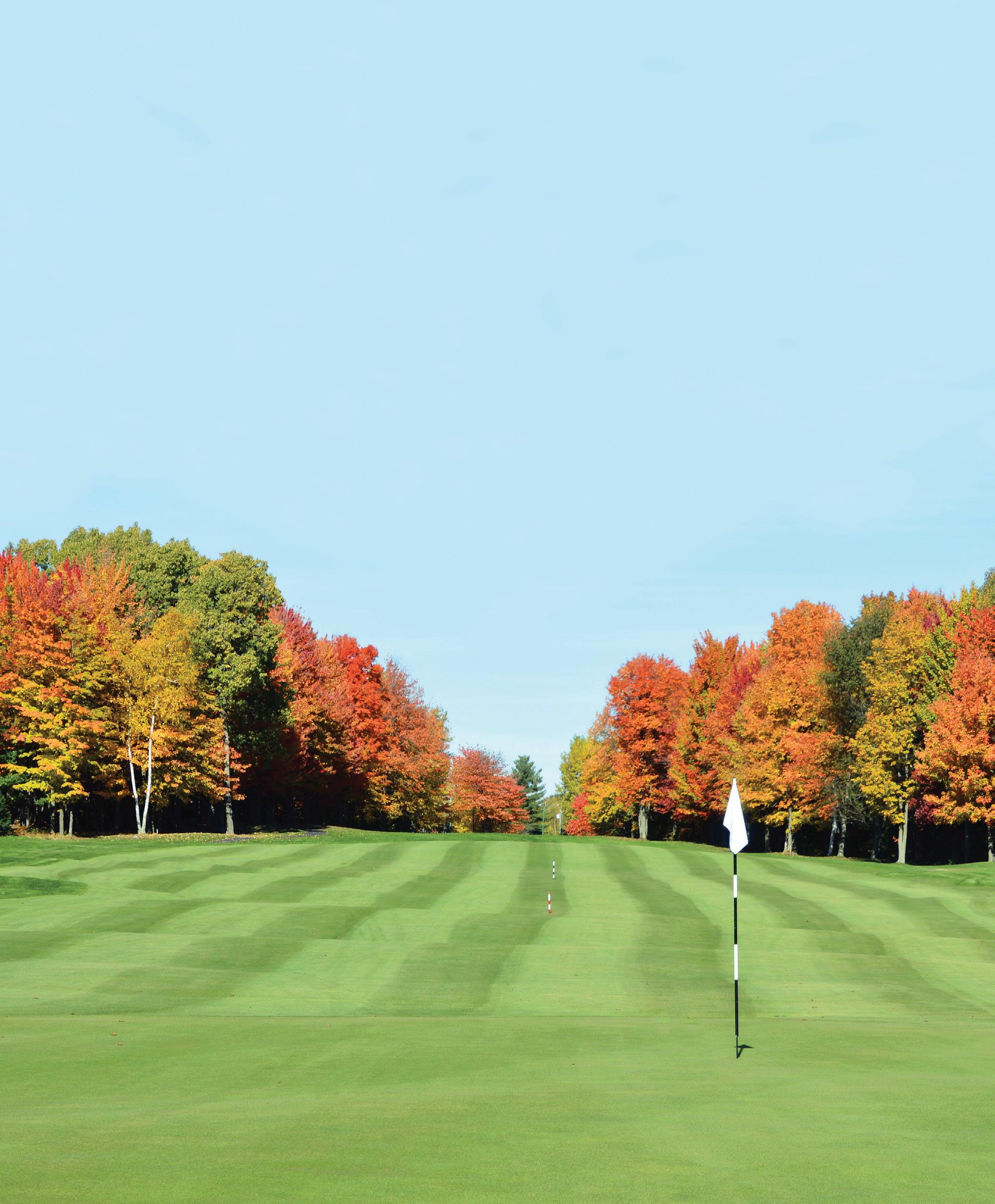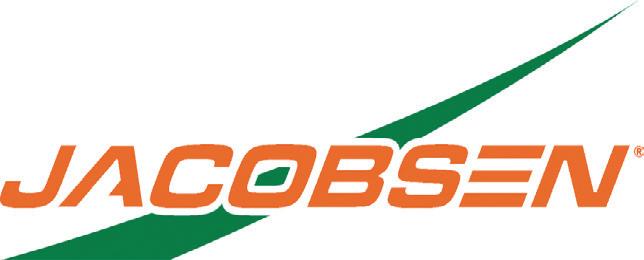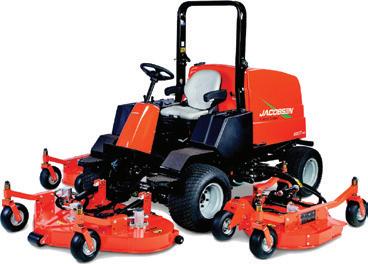
18 minute read
Feature We’re all in this together
We’re all in this together:
a fairway annual bluegrass control story
Advertisement
DR. THOMAS A. NIKOLAI LED BY AARON HATHAWAY AND JARED MILNER
Most have heard the proverb “When life gives you lemons, make lemonade” which suggests we should strive to make the best out of a bad situation. Clearly, members and management at Meadowbrook Country Club (MCC) chose to make a lemonade stand from their misfortune. Misfortune number 1 was the application of the very effective broadleaf herbicide aminocyclopyrachlor (Imprelis) in 2010 which led to significant tree damage/death and an eventual settlement of over 2 million dollars. If you are too young to know the story, simply Google “Imprelis”.
Jared Milner stands atop his patch work fairway ABG control plots.

IMAGE 2
IMAGE 3
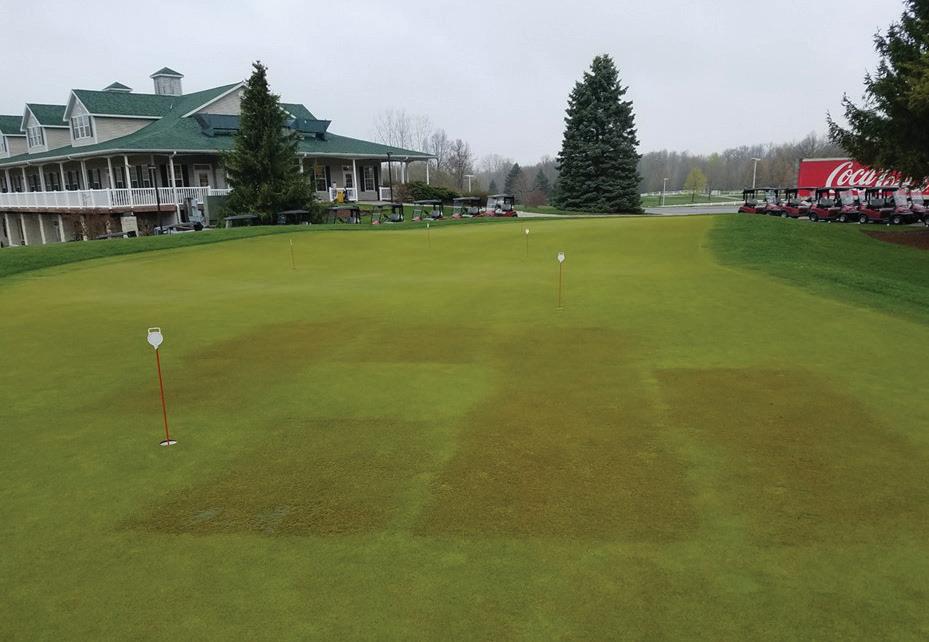
IMAGES 2 & 3 In the fall of 2018 Aaron Hathaway sprayed the same experimental product to control annual bluegrass in creeping bentgrass greens. Both greens were within 10 miles of one-another and were sprayed on the same day, by the same person, with the same equipment. Both images were taken on April 30, 2019. Clearly, the image on the right has some good control of ABG in the 3 plots that can be seen in row 1. Even more clearly, the amount of damage caused by the product in image 2 is unacceptable. These two images show 1) why it takes so long to get an experimental product to market and 2) whenever you use a new herbicide or PGR on your side it is prudent to be cautious and start with some small plots before making a blanket application on all your greens, tees, or fairways.
Misfortune number 2 became evident with the snow melt in late winter/early spring of 2014 exposing a significant loss of annual bluegrass (ABG) due to winter kill. These combined misfortunes led to 72% membership support for redesigning their Willie Park Jr. course under the direction of architect Andy Staples. Ground was broken for reconstruction in October 2015 with plans to have it ready for play in May of 2017. Obviously, the expectation among some of the members was their course would be rid of ABG forever.
On November 30, 2015 Jared Milner was hired as the golf course superintendent to oversee the grow-in. The fairways at MCC were seeded to PureFormance Blend (Crystal blue links, Penn links II, and Pure Select) creeping bentgrass. Prior to seeding, the fairways were sprayed 3 times with glyphosate (Roundup) in an attempt to kill all the vegetation. Dazomet (Basamid) soil sterilant was
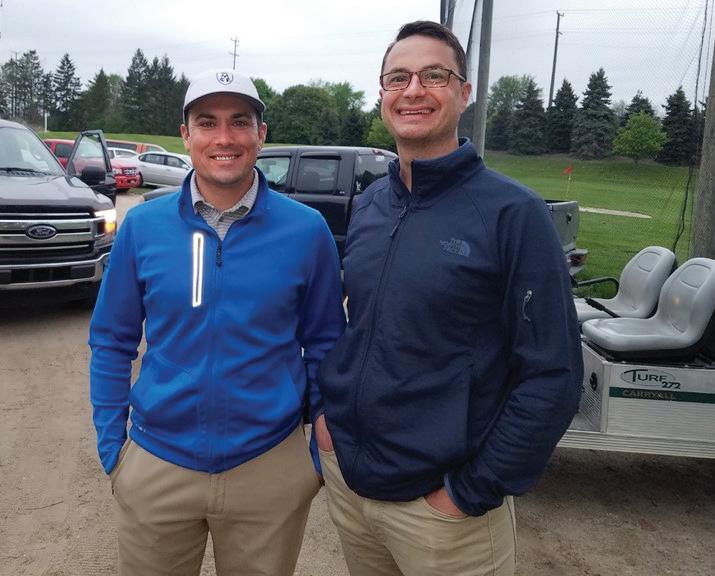

Jared Milner early on in the construction phase at Meadowbrook Country Club. Do, in part, to difficulties in finding qualified labor Jared brings in his daughter Naydine in for assistance.
considered, however, the members chose not to spend the additional $150,000.00 for the application.
Jared knew that keeping ABG out of the fairways was very important to many of his membership, so 30 days after the initial seeding he started using bispyribacsodium (Velocity) to keep ABG at bay. Jared explained, “During reshaping, some of the fairways had 1-inch or more of the soil removed. Those areas did not have very much ABG encroachment. However, in areas that did not have soil removed there was visible encroachment of ABG early on.” Jared added, “Velocity has been doing a nice job keeping ABG controlled on our fairways, but even though the members do not want the return of ABG, many object to the discoloration caused by Velocity” and, of course, the production of Velocity was halted in 2017 making it harder to acquire.
At the 2019 Michigan Turfgrass Foundation Conference in East Lansing, MI I walked into a conversation between Jared and Aaron Hathaway. A plan was being hatched to perform an ABG control study on MCC’s fairways with the objectives of keeping the infestation to a minimum with little, preferably no, discoloration. The first research I ever performed was in 1990 working for Dr. Bruce Branham. It was a plant growth regulator study that included an experimental product called trinexapac-ethyl (Primo). Clearly a lot has changed in the world of ABG since then and I have not stayed on top of all of them so I was delighted when asked to be involved.
Products chosen to be included in the study along with their rates are presented in Table 1.
Aaron Hathaway became involved in turfgrass weed research in 1999 and he graduated with his master’s degree from MSU in 2005. His master’s research compared many of the new bentgrass cultivars, which have vastly increased tiller densities compared to older and once more common cultivars like Penncross. The Hancock Turfgrass Research Center is basically an ABG farm, we actually harvest the ABG seed to plant research plots. Aaron established putting green surfaces with different bentgrass cultivars, trafficked them, and measured the infiltration of ABG into each of them over time.
Table 1.
Product Treatment
Anuew Anuew + Xonerate Anuew + Trimmit Trimmit Trimmit Xonerate 70WG Anuew + Torque Velocity 17.6SG Anuew + Velocity Untreated control Rates, respectively
12 ounces/acre 8 oz./acre & 1 oz./acre 8 oz./acre & 10 fl. oz. /acre 12 fl. oz./acre 20 fl. oz./acre 1 oz./acre 12 oz./acre + 35 fl. ox./acre 2 oz./acre 8 oz./acre + 2 oz./acre Formulations, respectively
wettable granule (WG) WG & WG WG & suspension concentrate (SC) SC SC WG WG & SC Soluble Granule (SG) WG & SG
FIGURE 1.
Percentage of Annual Bluegrass per treatment from Meadowbrook Country Club Fairways 2019.

Intuitively, one would think the greater the density of a bentgrass cultivar the greater the reduction of ABG infiltration, however, Aaron’s research surprisingly showed that older cultivars, such as Penncross, performed better in the summer heat and made-up density when ABG struggled and the newer cultivars did not necessarily shine in the high heat of summer either. Key point, Aaron’s data shed light on the fact that ABG populations were always moving up and down, fluctuating with the seasons, along with the strengths and weaknesses of the differing bentgrass cultivars the ABG infiltrated.
HEALTHYTURF PLUS



35yearsofexperience,quality workmanship&customersatisfaction
Aaron states, “There have been, and there remains, a select few effective herbicides for ABG removal or prevention in cool season putting greens, so other methods for ABG control are important. Back in 2005 paclobutrazol (Trimmit) and flurprimidol (Cutless) were really the only options for ABG control in bentgrass greens. In fairways, the same 2 plant growth regulators (PGRs) were available, but I started to work with a few herbicides categorized as postemergence herbicides for ABG control like Velocity and amicarbazone (Xonerate). Neither were commercially available at that time and today only the Xonerate remains as an option. Ethofumesate (Prograss) was another product on the market and some gutsy superintendents actually used Roundup like a PGR at low rates to slowly favor the bentgrass over ABG. Certain preemergence products have been around for a long time, but few are willing to use them. It makes sense to use preemergence herbicides to control a weed like ABG that primarily infiltrates golf turf through germination of seeds, but the potential for root pruning and the inability to interseed in a pinch is a huge drawback.
Control of ABG on golf courses is difficult because it is almost always a considerable percentage of the overall turf stand. The decision to control ABG often becomes a decision to kill much of that stand along with injuring the favorable turfgrass species. For example, Velocity at higher rates (2 apps at 30 g ai/A) or a few well-timed spring applications of Xonerate will very selectively and effectively kill ABG on a fairway. This would be great if the fairway has 5-10% ABG, but older fairways have much more ABG. Due to that fact we began to treat postemergence herbicides like PGRs, applying them at much lower rates to injure the ABG and favor the bentgrass hoping that, over time, ABG will fade away and bentgrass will take over. However, it seems that superintendents really didn’t like either option – bare ground was out and season-long use of herbicides that also injure bentgrass (not kill, but cause phytotoxicity) was also out. Really, golf course managers want something better – a product that effectively kills all ABG in a medium amount of time yet allows the bentgrass to fill in with very little visible turnover.”
In 2016, Jared started spot spraying areas he knew had the most ABG populations with Velocity at the 3 oz. rate, however, when spot spraying, phytotoxicity in treated areas stood out to the members. Jared added, “Blanket treatments resulted in every fairway displaying even amounts of turfgrass injury which were not as objectionable as the phytotoxicity from spot spraying. For that reason I won’t go back to the spot spraying method of application again.”
So in the spring of 2019 a replicated study was initiated in a fairway at MCC with the 11 treatments listed in Table 1. Nine applications were made two weeks apart followed by %ABG and phytotoxicity ratings taking place by Jared, Aaron, and myself separately and together on several occasions. Again, the objective was to determine which treatment led to the greatest decrease in the %ABG with as little visible phytotoxicity as possible.
The percentage of decrease of ABG per treatment was taken on September 20, 2 weeks after the final treatment of the season, and is listed in Figure 1. Notice the Xonerate and the Torque plots had a greater %ABG than the untreated check. The treatments that resulted with plots having the least %ABG were treated with Anuew, Trimmit at the high rate, Velocity, and the Anuew/Velocity combination treatment. In Figure 2 are the quality ratings taken on five dates from each treatment throughout the year. Quality ratings were taken 5, 5, 4, 17, and 11 days after treatments were applied, respectively. For this study quality ratings took into account the density of the plots, color, and most significantly the phytotoxicity caused by the treatment. It should be noted that Trimmit, in particular, can cause wider leaf blades and longer internodes which would have been included in overall quality ratings subjectively.
FIGURE 2.
Bentgrass fairway quality ratings on a scale of 1-9 from Meadowbrook Country Club Fairways 2019. Quality ratings in this case took into account the density of the turfgrass, color, and most significantly the phytotoxicity caused by the treatment. The number 1 reflects the worst possible rating, 6 and above is acceptable quality for a bentgrass fairway, and 9 is turfgrass quality only God can obtain on a bentgrass fairway in Michigan and he was not on our team.

To interpret the data, the number 1 reflects the worst possible rating, 6 and above is acceptable quality for a bentgrass fairway, and 9 is turfgrass quality only God can obtain on a bentgrass fairway in Michigan. Notice the Velocity treatment resulted in below acceptable fairway quality on each rating date primarily due to phytotoxicity on the turfgrass. Tank-mixing the Anuew with the Velocity decreased the visible injury and overall the Trimmit at the low rate and the Anuew resulted in the best overall fairway quality at MCC.
So, given the results in Figures 1 and 2 and the stated objective of the study it is easy to conclude, that for the mixture of bentgrass species grown in the soil at MCC the best product in this study was Anuew. So I asked Jared, “Did the results of this study change how you will perform ABG control on your golf course fairways?” Jared’s more cautioned response was, “Yes, but still not sold on a product or program. Time will tell. Velocity was the ticket but it is gone. Members who looked at the plots with me always picked out Anuew or Anuew + Trimmit.” Aaron added, “Results we have from this spring (i.e. 2020) are much different from what we had at the end of 2019. Much of the ABG came back, which means we were really suppressing ABG with some of these – this is definitely part of the story: PGRs (Trimmit and Anuew in particular) will work to suppress ABG in bentgrass over time and serve as a tool in the tool chest. Velocity plots had ZERO ABG this spring – but it cannot be purchased anymore so one less tool. I think PGRs can be helpful especially if you start with very little Poa, but other tools are necessary, such as dry downs, a postemergence herbicide [like Velocity or maybe PoaCure], and, perhaps, well-timed preemergence herbicides.”
The long-awaited methiozolin (PoaCure) product has hit the market and it is promising. PoaCure should be watered in to inhibit root production of ABG slowly (usually) killing ABG over time and allowing bentgrass to fill in the voids as it works. PoaCure also provides preemergence activity in the soil, which, again, is a huge plus for control of ABG, but can cause problems if any reseeding is necessary. Every golf course is different and even every putting green has differences that affect the starting health of the ABG and the majority of biotypes (more perennial or annual types), which changes how quickly a herbicide will kill ABG. Aaron added, “No matter which herbicide or PGR I
have used over the years, they work differently and/or more quickly at one site versus another even when I apply the same product at the same rate on the same day in locations a half-mile apart.” Please see Images 2 and 3.
The golf course turfgrass business is made-up of different pillars. The key pillars are the golf course superintendent, industry, and research (Image 4). No one group leads, but we are all bound together and the more we communicate and work together the stronger and more knowledgeable our business will be. I consider myself fortunate to be included in studies like this. I had planned to travel to several golf courses and sod farms this summer to gain insights. Last year I was also included in a project with the support of Jerry Husemann, Kimberly Rouleau, Mike Morris, and Don Roth looking at control of weeds in “no mow areas” that I had planned to continue this year but that was not to be. Perhaps this pandemic will be behind us next growing season and I can continue down that path. Until then, thanks for your support and be assured you have mine.
Is your soil living up to its full potential?
If you aspire to grow championship-quality turf, then building a foundation of soil teaming with bioactivity should be your #1 goal. We offer you a complete product line and proven methods to attain those results. Along with a deeper respect for the work you do.
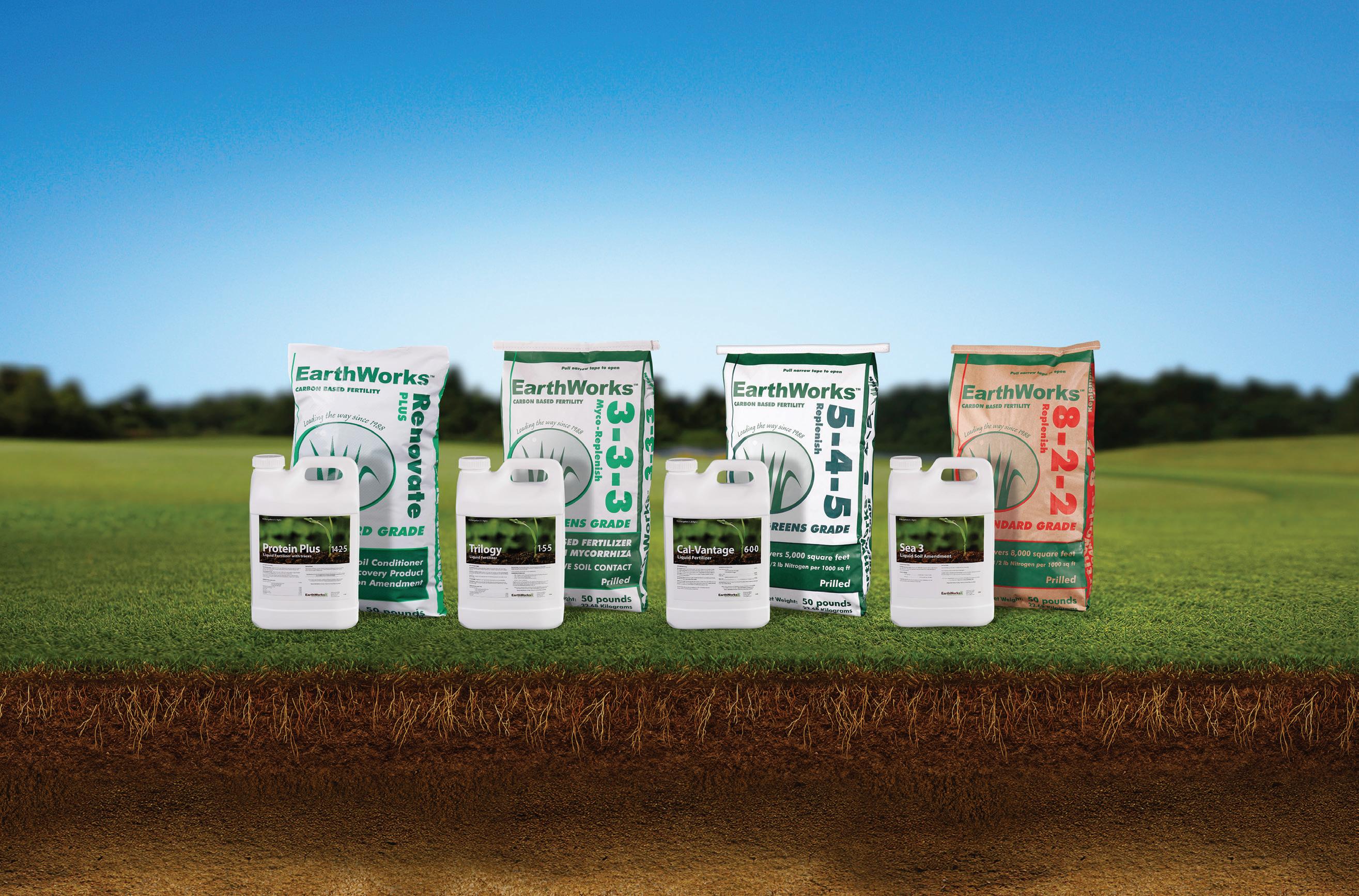
A Deeper Respect
Chad Kuzawa, Regional Agronomist | 616-255-2818 | chad@soilfirst.com www.earthworksturf.com | 800.732.8873
©2020 EarthWorks Turf
To Tree or Not to Tree…………… that is the Question

BY A. PAUL ALBANESE, ASGCA
Trees
on golf courses. Controversial, usually.
When golf started back on the links land of Scotland, there was no talk of trees with relation to golf, because there were not any. The controversies of that era were more about rabbit holes, sheep dung and whether golf interfered with archery practice.
But, as golf evolved, and especially as it migrated across the pond, trees became part of the golf design palette. And, like all golf design elements, trees have been utilized both well and poorly over the years.
Recognizing there are not “right” or “wrong” answers in art and design, this commentary is simply my take on what I think works well with regard to how trees are used in golf architecture. Beauty is in the eye of the beholder, and the following comments are not meant as golf design gospel, but simply what I have seen over 28 years in golf design.
Trees are often quite beautiful and people playing on a golf course appreciate their splendor. Yet, golfers also enjoy hitting off turf and putting on bent grass versus dirt. And, I recognize where this column is being printed and that I am preaching to the choir on this point. So, a simple question a golf superintendent can ask any golfer that decries the loss of a tree: Do you want quality turf or a beautiful tree? It is a choice that golfers need to comprehend, and the decision is simply one of science. You cannot physically have both.
Another tree issue that continues to amaze me, are how many trees have been planted in locations that diminish the optical composition of a golf hole. An architect usually has a vision for how they believe a golf hole will look when viewed from the teeing area. They will often place bunkers in spots that work to offset another visual aspect of the hole, creating what I call the “postcard” view. It is artistry. And then, much to the chagrin of the original architect, a tree will be planted that will take away, and sometimes ruin, this picture. Clearly, the planter of these offending trees did not account for this artistry, especially when the trees are planted literally in front of a bunker the designer meticulously created for the beholder to enjoy; only to have it bifurcated by the tree planter. Before planting a tree, at a minimum, one should view the hole from the teeing area to appreciate the canvas on which they are splashing a tree. And then, reconsider.
Golf is a hard-enough sport already. And, I often see trees planted in locations that just make the game too hard. The favorite being near a green complex, supposedly “off to the side” and not interfering with the visual composition or even the turf conditions. Yet, located on the outside edge of a bunker, this type of tree will often create the almost impossible shot. A golfer finds his ball under or behind this tree, and they then have unenviable position of not being able to run the ball up to the green due to the bunker, and also not hit a higher shot due to the limbs of the tree. In my book, this is patently penal (read: unfair) golf course design. A golfer should not be penalized with an almost impossible shot by simply hitting it near a tree not far from the green.
Specimen trees can be a great addition to a golf hole, when properly vetted and thought about prior to planting. And, once ONE good tree is planted, there is usually no reason to continue planting more trees around it. In fact, on many old turn-of-the-century designed golf courses, we spend a lot of time and effort removing the many trees that have been planted around that unique specimen tree. The results always being “less is more” and the removal of many trees will often make that
single specimen tree become more focal, interesting and memorable.
Golfers don’t hit the ball straight off the tee. They often start out right or left, and then move one way or the other, with hopes of ending up in the middle of the fairway. Yet, those planting trees will often stand in the middle of a tee box, and point a straight line to the fairway and declare the trees on the edges of the hole a non-issue. Inevitably, these trees grow, and then force golfers to only be able to play to one side of the fairway, or not be able to have the ball move from side to side, which is not something even the pros do.

Tree planting seems like a benign endeavor for a greens committee or golf operator to do. People love trees and who would argue about beautifying a golf course? But, if trees are an imperative, they need to be designed, planned and managed with similar diligence as all other aspects of the design.
Erwin McKone is a Michigan native, growing up in Flint, Michigan was introduced to turfat Genesee Valley Meadows. Erwin earned a Bachelor ofScience in Biology at the University ofMichigan and was a Research Assistant for Bruce Branham at the University ofIllinois. Erwin served as ChiefOperating Officer and Director ofGolfOperations at Briar Ridge Country Club prior to joining the TurfVentures team in 2016.
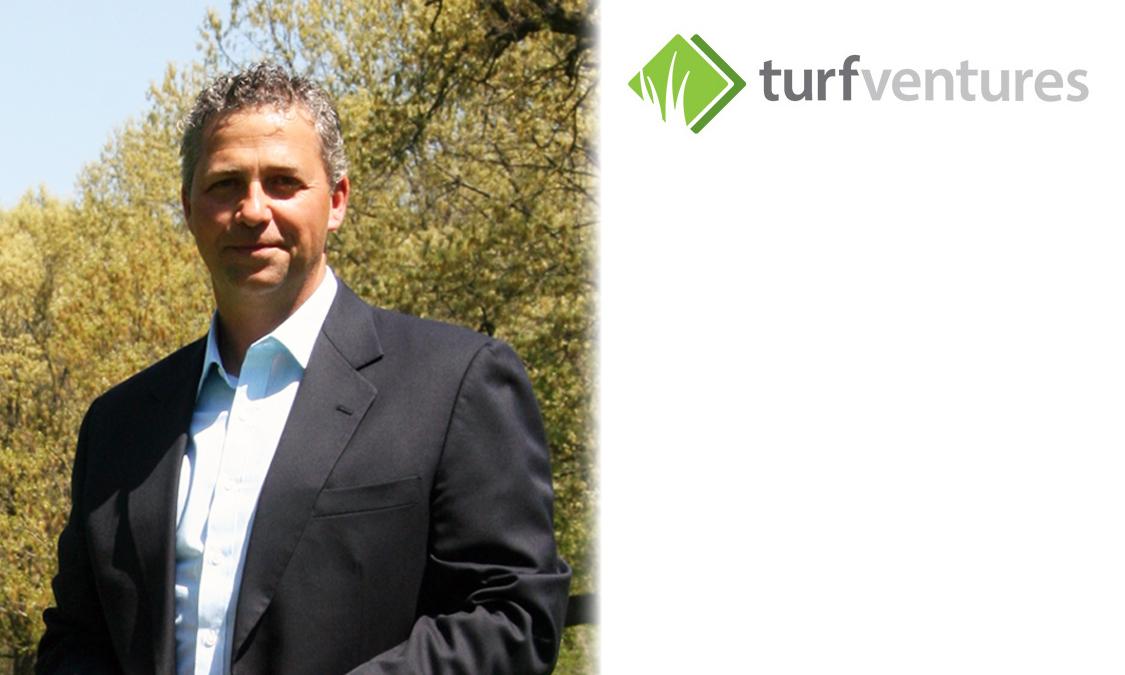



TurfVentures is a major distributor ofchemicals and supplies. The company philosophy emphasizes playability as guiding principle for agronomic decisions. TurfVentures believes in common sense agronomic principles and proven cultural practices to ensure the success ofits partners.
ErwinH. McKone, CGCS 219-688-0089 erwin@chicagolandturf.com

